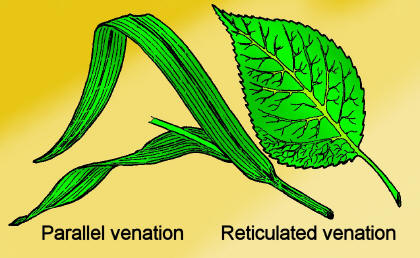|
There are lots of different types of
leaf venation that are important for
plant identification.
The term venation
refers to how veins are distributed in the
leaf blade, Usually
lamina
comprise anastomotic veins that are veins ending in a closed point (e.g.
terminating or fused in a
leaf apex) while "non"-anastomotic veins which endings
are free are quite infrequent.
There are two principal types of venation:
parallel-veined
and reticulated-veined:

The veins on
monocots are almost parallel to the
margins of the leaf
whereas in dicots radiate
from a central primary
midvein that gives
rise to secondary or lateral veins and in turn tertiary veins and
veinlets
PARALLEL-VEINED-LEAVES:
In parallel-veined leaves, numerous veins run essentially parallel
to each other and are connected laterally by minute, straight
veinlets. Parallel-veined leaves occur most often on
monocotyledonous plants. The most common type of parallel veining is
found in plants of the grass family, whose veins run from the leaf's
base to its
apex. Another type of parallel venation is found in
plants such as banana, calla, and pickerelweed, whose veins run
laterally from the midrib.
RETICULASTED-VEINED-LEAVES: In
reticulate-veined leaves (also called
net-veined), veins branch
from the main rib or
ribs and subdivide into finer
veinlets. These
veinlets then unite in a complicated network. This system of
enmeshed veins makes the leaf more resistant to tearing than does a
parallel vein structure. Net-veined leaves occur on
dicotyledonous
plants.
Net venation may be either pinnate or
palmate. In pinnate venation,
the veins extend laterally from the midrib to the
edge . In palmate venation, the principal
veins extend outward, like the ribs of a fan, from the base of the
leaf blade .
Some different venation patterns of
dicots leaves are illustrated
below: |